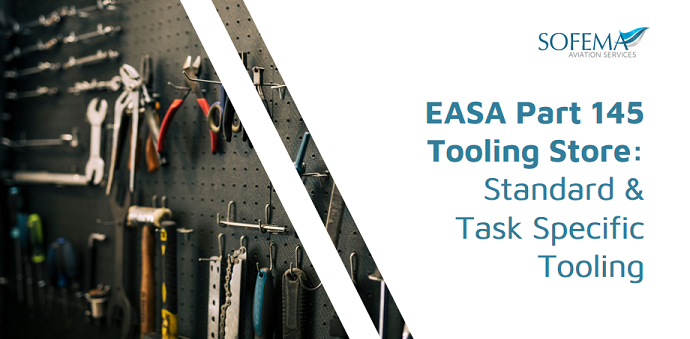Sofema Aviation Services (SAS) www.sassofia.com considers tooling control & assessment related to Standard & Task Specific Tooling
Introduction
It is necessary to have a different level of tooling assessment depending on the related role purpose and complexity of the tooling and or equipment.
The basic classification is in the following categories:
- Standard Tooling;
- Task Specific Tooling.
Standard Tooling & Equipment – What are Standard Tools?
- Standard tooling is considered as those tools and equipment which are not identified as required for exclusive use within aviation.
- They are also typically available commercially.
- Additionally, they are generically identified by the maintenance data by type and/or family and/or characteristics.
Regarding the need for assessment related to the use of “standard tooling”
- It is accepted that the end-user – technician, certifying staff, etc. Has the necessary knowledge to enable any required determination related to the use of such tooling. (Before starting the maintenance task, that the tooling is adequate to perform the intended work.
- A formalized equivalence assessment is not required.
Note: the maintenance organisation may elect to develop such an equivalence assessment if relevant or useful.
Examples of Standard Tooling & Equipment (Note – Values shown are typical and representative only)
- Ladders
- Access platforms
- Screwdrivers – various
- Standard wrench
- Protective covers
- Grease Gun
- Circuit breaker safety clip
- Nitrogen bottle charged to 3000 psi
- Multimeter ±5% accuracy used to measure 115 V, 28 V, and 28 volts DC
- Torque wrench 0 to 300 inch -pounds
- Pressure Gage, 800 to 2500 PSIG
- Hydraulic jack nose gear
- Portable Hydraulic Cart, Capable of 3000 PSI, and a minimum flow of 50 GPM
Task specific Tooling – What are Task specific Tools?
Task Specific tools are those tools and equipment designed for the particular Aircraft / Engine / Component / NDT / etc. usually the use of such tooling is identified within a maintenance task as well as being specifically identified within the maintenance data (i.e. by P/N, supplier, and description).
Concerning the use of “Task Specific Tooling”
The maintenance organisation has the following options:
- acquire/use the “task specific tooling” as indicated by the maintenance data (exact P/N, supplier) and in such case, there is no need of any further equivalence assessment.
- acquire /use different tooling from the one specified in the maintenance data. Such replacement tooling is defined, as “alternative tooling” and may be used only subject to compliance with a procedure acceptable to the Regulatory Authority.
Note 1 – The maintenance organisation may elect to develop such an equivalence assessment if relevant or useful.
Note 2 – When the maintenance data itself identifies alternate tools, the maintenance organisation may use the main or the substitute tooling without any need for further equivalence assessment.
Next Steps
Sofema Aviation Services provides the following 1-day training course covering the essential areas of the Part 145 Tooling Store
Please see the following link or email team@sassofia.com
Part 145 Stores Tooling Control, Inspection Procedures & Best Practice – 1 Day
Tags:
aviation, EASA Part 145, EASA Part 145 Stores, SAS blogs, Tooling Control, Part 145 Tooling Store, Aviation Tooling Store, Standard Tooling, Task Specific Tooling





